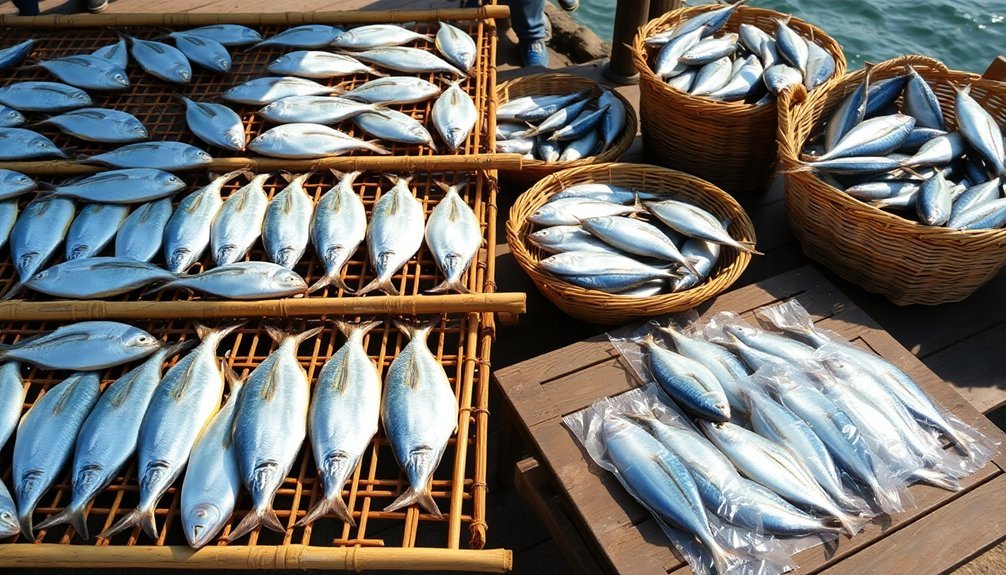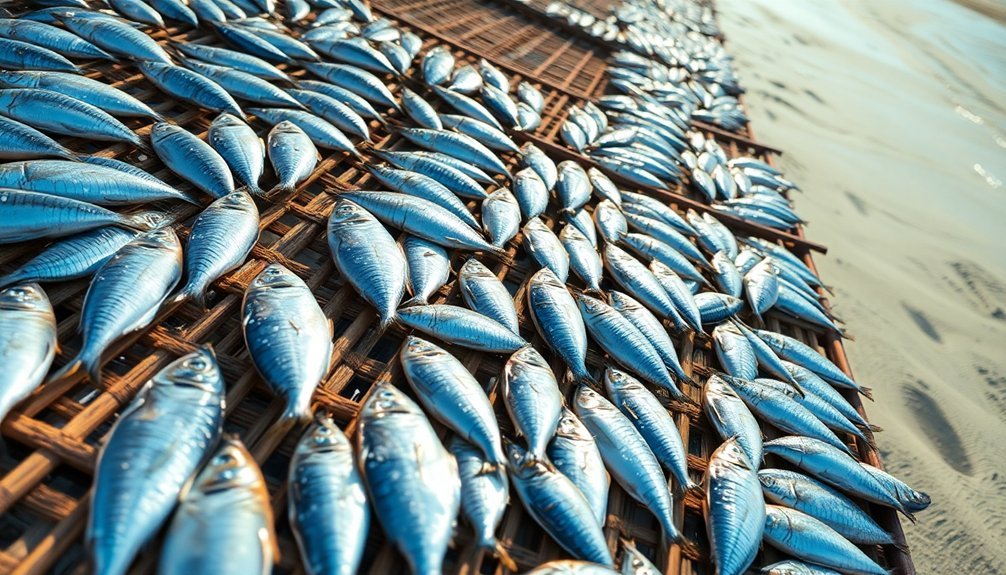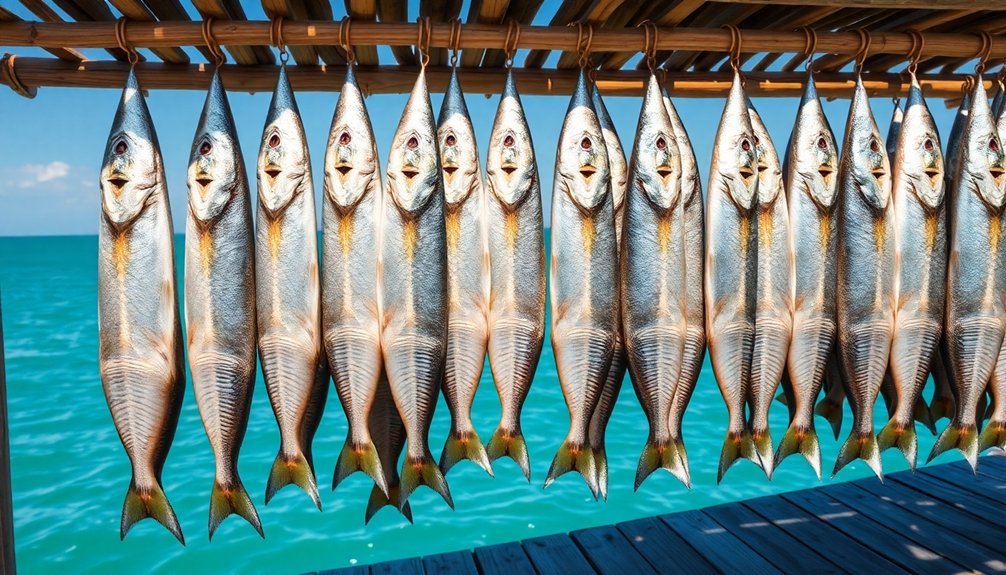You'll find sun-dried fish preservation offers double the protein content of fresh fish while maintaining essential nutrients. To get started, rinse and cut your fish into uniform strips, then use a salt brine solution (about 190kg salt per 1,000 fish). Dry your fish between 9am-5pm in temperatures 35°C above ambient air, with 50% relative humidity and good air circulation. For best results, use a solar dryer or forced convection with 3.5 m/s fan speed. Store your dried fish in airtight containers at 40°F or below. This ancient coastal practice holds even more secrets for modern preservation success.
Ancient Wisdom Meets Modern Practice

Sun-drying fish has stood the test of time as humanity's oldest preservation method, bridging ancient practices with modern innovations. You'll find this technique particularly prevalent in coastal regions and developing countries where refrigeration isn't readily available. The process requires nothing more than direct sunlight, wind, and open spaces to naturally remove moisture from the fish. Good air circulation allows for optimal moisture evaporation and prevents tissue decomposition.
While traditional methods rely solely on weather conditions and can take several days, you'll now see a blend of ancient wisdom with contemporary techniques. You can enhance preservation by combining sun-drying with salting, using a fish-to-salt ratio between 3:1 and 6:1. This combination considerably extends your fish's shelf life and inhibits bacterial growth.
Modern industrial practices have introduced mechanical dryers that speed up the process while maintaining quality control. You'll get faster, more hygienic results compared to traditional methods, especially when preserving fish commercially.
These improvements don't compromise the nutritional benefits – sun-dried fish contains nearly double the protein content of fresh fish. When stored properly in cool, dry conditions, you can keep your sun-dried fish for several months to a year.
Essential Steps for Fish Drying
The successful preservation of fish through drying begins with four critical phases: preparation, marination, drying, and monitoring.
You'll need to start by preparing your fish properly. Rinse and pat it dry, then cut it into uniform strips about ¼ to ⅜-inch thick. Remove any blood, viscera, and the black membrane from the belly cavity, and skin the fillets carefully for best results. Select fish with bright clear eyes for optimal freshness.
For marination, you'll want to use either a salt brine solution or dry salting method. If you're using brine, make it with boiled and cooled salt water. For dry salting, layer your fish with fine salt, using roughly 190-200 kg of salt per 1,000 split fish.
You've got several drying options: use your oven at its lowest setting (around 145°F), employ a dehydrator, or hang the fish in the sun. Whichever method you choose, guarantee proper air circulation and keep the pieces from touching each other.
During the drying process, you'll need to monitor for case hardening and turn the fish periodically. The final product should have less than 30% moisture content.
Store your dried fish in a cool, dry place with good airflow.
Optimizing the Drying Process

Successfully enhancing your fish drying process requires careful attention to both environmental factors and equipment settings.
You'll want to maintain temperatures about 35°C higher than the ambient air, while keeping relative humidity at approximately 50%. Traditional methods like open sun drying often lead to product deterioration and poor hygiene. For best results, conduct your drying operations between 9:00 am and 5:00 pm to maximize solar radiation exposure.
When using a solar dryer, you'll achieve ideal results by following specific dimensional guidelines. Set up your dryer with a length of 70 cm, height of 40 cm, and breadth of 60 cm. Position your drying trays 25 cm from the base for enhanced efficiency.
If you're using forced convection, set your fan speed to 3.5 m/s to improve drying rates considerably.
Monitor your process carefully using thermocouples and data loggers to maintain optimal conditions. You'll need to dry the fish until it reaches a moisture content of 13-15% to prevent microbial growth.
While different drying methods will affect the fish's physical characteristics, forced convective solar drying offers the best balance of efficiency and quality, achieving up to 74.3% drying efficiency during the dry season.
Safe Storage and Handling
Proper handling begins the moment your fish leaves the water, long before the drying process starts. You'll need to clean your catch immediately and keep it chilled with crushed ice – one pound of ice for every two pounds of fish – to prevent spoilage bacteria from multiplying.
Remember, fish deteriorate quickly at warm temperatures, so maintaining proper refrigeration at 40°F or below is essential for preserving quality.
For successful long-term storage of your sun-dried fish, you'll need to focus on these vital factors:
- Storage containers must be airtight or vacuum-sealed to protect against moisture and contamination.
- Temperature and humidity levels should remain stable in your storage area.
- pH levels must stay below 6.8, and total plate count shouldn't exceed 1 × 10^5 cfu.g^-1.
You'll want to monitor your stored fish regularly, checking for any signs of mold growth or quality changes.
Test the surface occasionally – it shouldn't stick to your finger when touched. Keep track of moisture content, protein levels, and fat content through monthly quality checks.
Coastal Communities and Cultural Heritage

Across coastal communities worldwide, sun-dried fish preservation represents far more than just a practical method of food storage – it's an essential thread in the cultural fabric of maritime societies.
You'll find that traditional fishing communities possess invaluable ecological knowledge passed down through generations, encompassing sustainable resource management and preservation techniques. In places like Assam, you'll discover sun-dried fish being used not just for food but also in traditional medicine and healing practices. The protein content in these preserved fish is nearly double that of fresh fish, making them nutritionally significant.
When you explore coastal heritage sites, you'll notice how sun-dried fish production contributes to local economies through tourism and cultural preservation. These traditional practices create jobs and help maintain community identity, though they're increasingly threatened by urbanization and climate change.
You'll see efforts by organizations like UNESCO and various European initiatives working to protect these cultural practices through legislation and conservation programs.
If you're interested in sustainable fishing practices, you'll find that traditional maritime knowledge continues to play a vital role in supporting vulnerable coastal communities while ensuring food security for future generations.
Frequently Asked Questions
Can Sun-Dried Fish Trigger Allergies Different From Regular Fish Consumption?
You'll experience similar allergic reactions from sun-dried and regular fish since they contain the same allergens, but sun-dried fish's concentrated protein content may trigger more intense responses due to higher allergenic loads.
How Does Air Pollution Affect the Quality of Sun-Dried Fish?
Air pollution deposits harmful particulates on your drying fish, leading to chemical contamination, increased lipid oxidation, and poor flavor. You'll notice reduced quality, off-odors, and potential heavy metal contamination in polluted areas.
What Fish Species Are Unsuitable for Traditional Sun-Drying Methods?
You'll want to avoid sun-drying fatty fish like mackerel and sardines, delicate species like sole and flounder, and larger fish like grouper. They're prone to rancidity, breakage, and uneven drying.
Does Moon-Drying Fish at Night Affect the Preservation Process?
You can't effectively dry fish by moonlight since it lacks the heat and UV radiation needed. The cooler temperatures and higher humidity at night will actually slow down preservation and risk bacterial contamination.
Can Sun-Dried Fish Be Used as Pet Food or Animal Feed?
You can safely feed sun-dried fish to your pets as it's rich in omega-3, DHA, and essential amino acids. It's best used as a supplement to their regular diet, not as their main food source.
In Summary
You'll find that sun-dried fish remains one of the most reliable and sustainable preservation methods in coastal regions today. By following proper drying techniques, protecting against contamination, and storing your product correctly, you're not only preserving seafood but also maintaining an essential cultural tradition. Whether you're a commercial producer or home practitioner, you're participating in an age-old practice that continues to prove its worth in modern times.





Leave a Reply